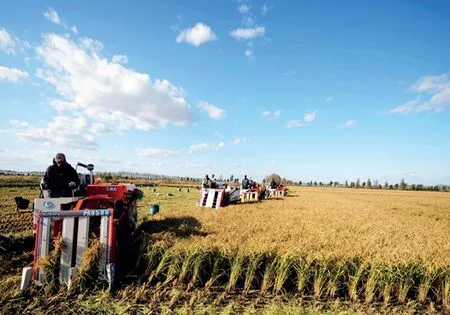Feeding China
2010-10-16ByHUYUE
By HU YUE
Feeding China
By HU YUE
China is expected to reap a bumper harvest this autumn,but grain security remains a long-term concern
D espite sweeping natural disasters,
China is on track to achieve a bountiful harvest for this autumn’s grain yield, which usually accounts for three fourths of the annual output, said M inister of Agriculture Han Changfu.
W ith the autumn harvest secured, w inter planting is already underway across the country, said Han.
China’s grain output, including rice,wheat and corn, amounted to 530.8 m illion tons in 2009, the sixth consecutive year of grow th. The output for this year, according to Han, w ill be no less than last year and is likely to hit a new record.
The M inistry of Agriculture (MOA) anticipated that the acreage planted for autumn grain would increase by around 870,000 hectares to 76.6 million hectares this year.
But vigorous efforts are still needed to strengthen grain supply and quality, said Han.
The news dismissed worries about food shortages given heavy summer rainstorms across the country and the severe drought in the southwest that disrupted agricultural production.
In a recent report, the MOA said grain output harvested this summer fell for the fi rst time in seven years to reach 123.1 m illion tons, down 0.3 percent, or 390,000 tons,from a year ago. In addition, the per-hectare yield dropped 0.4 percent year on year to around 4.49 tons, and the situation was even worse in disaster-stricken southwest Yunnan and Guizhou provinces.
However, w inter wheat, which usually makes up around 80 percent of the total annual wheat output, stood at 108.8 m illion tons this year, about 1 m illion tons more than last year, said MOA spokesman Chen Mengshan.
In another move, the China National Grain and Oils Information Center in September predicted the country would yield 169 m illion tons of corn in 2010, representing a year-on-year grow th of 3.1 percent thanks to increased planting.
The only cause for concern was rice,which accounts for half of the country’s grain output, said Jiang Heping, a senior researcher at the Chinese Academ y of Agricultural Sciences, in an interview w ithCapital Weekmagazine.
At least 92 percent of the increased 76.6 m illion hectares was planted w ith corn, leaving little space for rice, he said.
In addition, the spring sow ing of rice was delayed by seven to 10 days in many provinces because of the winter freeze earlier this year, he said.
That means the crops w ill face more risks of an early frost, said Jiang.
Recoup ing the losses
Before the relentless rains had stopped pouring water over many regions of China this summer, worries were proliferating about the country’s grain security.

PLENTY TO HARVEST: Farm ers reap rice in northeast Heilong jiang Province. The country has m ain tained a steady g row th rate in g rain output in the past six years
Torrential rains washed away homes and triggered overwhelm ing mudslides that claimed hundreds of lives. The disaster also cast an om inous shadow over the agriculture sector as the storms devoured vast areas of farm land. The State Flood Control and Drought Relief Headquarters said more than 9,700 hectares of crops had been devastated by August 10, w ith direct econom ic losses totaling 209.6 billion yuan ($31 billion).
Before this, a prolonged drought ravaged southwest China, drying up farm land and leaving people in desperate need of drinking water.
On top of the natural disasters came the international grain crisis. On August 5,Russia, the world’s third largest wheat producer, ordered a ban on grain exports after a severe drought destroyed crops and as w ildfi res spread across the country. This ignited panic in the commodities markets, sending wheat prices to record highs.
Many fret the price surge may fi lter into China through trade links. From January to June, the country’s wheat imports more than doubled to 845,000 tons year on year, while rice imports soared 44.3 percent.
But the ripple effect has been barely felt, said Zhang Xiaoqiang, Vice Chairman of the National Development and Reform Commission (NDRC).
Despite the recent increase in imports,China relies on foreign markets for barely 1 percent to meet its demands for wheat, he said.
Beside this, the government has extensive reserves of grain and is capable of keeping food prices under control, he said.
China’s grain inventory-to-consumption ratio is now more than 40 percent, well above the international security line of 17-18 percent.
M eanwhile, a string of government measures have also helped shore up the agricultural industry, said Zhang.
The Chinese Government this year distributed 15.5 billion yuan ($2.3 billion) in subsidies for farmers to purchase agricultural machinery, compared with 70 million yuan($10.4 million) in 2004. It also bumped up the m inimum purchase price of rice and wheat.
A new season
While a bumper harvest is on the way for this year, the long-term grain safety is far from guaranteed given an expanding population and the grow ing living standards.
China expects its annual grain consumption to reach 572.5 million tons by 2020, and to maintain a food self-sufficiency rate of 95 percent, at least 540 million tons of grain output w ill be needed, said Zhang Ping,Chairman of the NDRC.
The goal is actually not w ithin easy reach given the country’s lim ited cultivated land,scarce water and relatively weak agricultural technologies.
To ensure sustainable grain supplies,China has enacted strict policies to protect arable land and also set a “red line” to guarantee its arable land never shrinks to less than 120 million hectares. But the country is already edging dangerously close to that line,w ith just 121.7 million hectares available by the end of 2009, according to data from the M inistry of Land and Resources.

In the past 13 years, China has lost 8.2 m illion hectares of arable land due to urbanization and forest and grassland replanting programs, as well as damage caused by natural disasters. The country’s per-capita arable land is now a minimum 0.092 hectare, only 40 percent of the world’s average.
It’s urgent now to curb decreases in arable land, which is crucial to grain security,said Zheng Fengtian, a professor at the Renm in University of China.
A lack of irrigation is also stretching the nerves of policymakers. The M inistry of Water Resources said water shortages to the agricultural sector stand at a dizzying 30 billion tons annually.
“This is the result of the drought climate in north China and the fragile irrigation infrastructure,” said Zheng. “Many irrigation facilities in the countryside are either outdated or broken.”
But the biggest question was how to encourage the farmers to plant more crops, said Ma Wenfeng, a senior analyst at the Beijingbased Orient Agribusiness Consultant Ltd.
Due to relatively low grain p rices,Chinese farmers earn much less than urban employees. That is why many chose to leave their land fallow and seek jobs in the cities,he said.
The number of m igrant workers across the nation had amounted to 23 m illion by the end of 2009, climbing 1.9 percent year on year, said the National Bureau of Statistics.
In the next 20 years, another 400 million rural residents may m igrate to cities, leaving even fewer farmers in the fields, said Zuo Xuejin, Executive Vice President of the Shanghai Academy of Social Sciences.
In response, it is necessary to boost farmers’ incomes and further strengthen subsidies for them to buy machinery and fine strains of crops, he said.
NDRC Chairman Zhang Ping suggested that the country should further strengthen its grain production capacity by improving agricultural infrastructure and expanding the use of high-yielding strains.
Efforts are also needed to press ahead w ith modern farm ing technologies and bolster the farmers’ ability to fight natural disasters, he said.
Zhang said China has established an initial emergency response system for grain security, and reinforced the production, storage, transportation and distribution of food and grain in emergency situations.
It would also be helpful if China could foster a number of international competitive grain processing enterprises, said Li Guoxiang, a researcher at the Rural Development Institute of the Chinese Academy of Social Sciences.
That would be instrumental in sustaining domestic grain supplies and fending off the impact of global price fl uctuations, he said.
